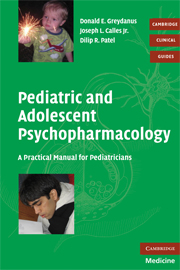Book contents
- Frontmatter
- Contents
- Contributors
- Foreword by Christopher K. Varley
- Foreword by Renée R. Jenkins
- Preface
- Acknowledgement
- 1 Principles of psychological management
- 2 The basics of pharmacology and neurotransmission
- 3 Basics of prescribing psychopharmacologic agents
- 4 Anxiety disorders
- 5 Attention deficit/hyperactivity disorder
- 6 Child and adolescent depression
- 7 Disruptive behavior and aggressive disorders
- 8 Schizophrenia in childhood and adolescence
- 9 Autism spectrum disorders
- 10 Psychotropic management of children and adolescents with cognitive–adaptive disabilities
- 11 Sleep disorders in children and adolescents
- 12 Tic disorders in children and adolescents
- 13 Substance abuse disorders
- Subject index
- References
3 - Basics of prescribing psychopharmacologic agents
Published online by Cambridge University Press: 18 December 2009
- Frontmatter
- Contents
- Contributors
- Foreword by Christopher K. Varley
- Foreword by Renée R. Jenkins
- Preface
- Acknowledgement
- 1 Principles of psychological management
- 2 The basics of pharmacology and neurotransmission
- 3 Basics of prescribing psychopharmacologic agents
- 4 Anxiety disorders
- 5 Attention deficit/hyperactivity disorder
- 6 Child and adolescent depression
- 7 Disruptive behavior and aggressive disorders
- 8 Schizophrenia in childhood and adolescence
- 9 Autism spectrum disorders
- 10 Psychotropic management of children and adolescents with cognitive–adaptive disabilities
- 11 Sleep disorders in children and adolescents
- 12 Tic disorders in children and adolescents
- 13 Substance abuse disorders
- Subject index
- References
Summary
In most parts of the world children with mental disorders have limited access to qualified child psychiatrists. The diagnosis and management of mental disorders thus mostly falls to the pediatricians and other practitioners providing primary care to children and adolescents.
Drug regulatory processes vary in different countries. In the USA, the regulatory agency is the Food and Drug Administration (FDA). The FDA regulates the safety and efficacy of drugs and the manufacturers' labeling and advertising. An increasingly cautious approach in the use of psychopharmacological agents has been suggested by drug regulatory agencies in recent years. This is exemplified in the USA by the FDA-required labeling of stronger warnings for all FDA-approved medications for attention deficit/hyperactivity disorder (i.e. stimulants, atomoxetine) regarding the potential for sudden cardiac deaths (Box), and the “black box” warning for all antidepressant medications regarding suicidal potential (Box).
Although more data are now available for many drugs used in pediatric psychopharmacology, for most the data on long-term safety and efficacy are insufficient. Only a handful of drugs have FDA-approved labeling for use in children and adolescents. Lack of FDA labeling does not necessarily indicate that a drug should not be used or is contraindicated for use in children; it means lack of controlled clinical trials in the pediatric age group to assess a drug's safety and efficacy. Thus, in most cases, the use of psychopharmacologic agents in children and adolescents is considered “off-label.” Various medications used in pediatric psychopharmacology are listed in Table 3.1.
- Type
- Chapter
- Information
- Pediatric and Adolescent PsychopharmacologyA Practical Manual for Pediatricians, pp. 49 - 60Publisher: Cambridge University PressPrint publication year: 2008

